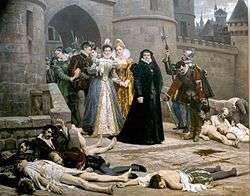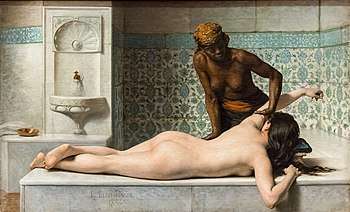Édouard Debat-Ponsan
Édouard Debat-Ponsan (Toulouse, 25 April 1847 – Paris, 29 January 1913) was a French academic painter noted for his allegorical works, scenes of peasant life and Orientalist works.
Édouard Debat-Ponsan | |
|---|---|
 Édouard Debat-Ponsan, c.1901 | |
| Born | 25 April 1847 |
| Died | 29 January 1913 Paris |
| Nationality | French |
| Education | Cabanel |
| Known for | Painting |
| Movement | Academic art, Oriental themes |
Biography
A pupil of Cabanel, Debat-Ponsan was famous for his portraits of wealthy citizens and politicians in Paris, paintings of ancient history and scenes of peasant life. As a Republican and veteran of the War of 1870, Debat-Ponsan engaged in the struggle for rehabilitation of Captain Alfred Dreyfus, he exhibited his allegorical painting Vérité sortant du puits (shown here) at the 1898 Salon, [1] later offered to Émile Zola.
In 1877 he traveled to Italy thanks to a sum of 4,000 francs which was granted to him by the Academy. There he saw different painting works, after which he began to paint portraits. In 1882-1883 he made a trip to Istanbul accompanied by his two brothers-in-law, Jules-Arsène Garnier and Henri-Eugène Delacroix (not to be confused with Eugène Delacroix). This trip inspired one of his most celebrated works, Le Massage, Scène de Hammam [The Massage at the Hamman] (1883) now in the Museum of Augustins in Toulouse.
He was Father of the architect and Grand Prix de Rome winner in 1912, Jacques Debat-Ponsan, and grandfather of Michel Debré, who became Prime Minister under General Charles de Gaulle and was one of the drafters of the Fifth Republic. Other descendants include the politician Jean-Louis Debré. His daughter Jeanne Debat-Ponsan married Robert Debré founder of modern pediatrics in France (see Debré family).[2]

Work
His scenes of rural life, very fashionable genre around 1830-1840, hesitate between an idealism of the peasant world and the militant realism of a Gustave Courbet. The painting, One morning at the gates of the Louvre may have political overtones. It depicts Catherine de' Medici (in black) calmly viewing the bodies of victims of the 1572 St. Bartholomew's Day massacre. Debat-Ponsan may have actually intended to refer to more recent events in French history, such as the bloody suppression of the Commune of Paris, nine years before this painting was made.
 One morning at the gates of the Louvre 1880
One morning at the gates of the Louvre 1880 La Vérité sortant du puits, or La Vérité sortant du puits, 1898
La Vérité sortant du puits, or La Vérité sortant du puits, 1898 Resting in the Field, 1901
Resting in the Field, 1901 La gitane a la toilette
La gitane a la toilette

Select list of paintings
- Le récit de Philetas c.1870 (now lost)
- La Captivité des Juifs à Babylone (now lost)
- Daniel dans la fosse aux lions (Cathedral of Mirande)
- Au sortir de la carrière, c.1870 (Toulouse, collection)
- Panorama de la bataille de Montretout, 1881(in collaboration avec Jules-Arsène Garnier et Henry-Eugène Delacroix)
- Panorama de Constantinople, 1883 (in collaboration avec Jules-Arsène Garnier et Henry-Eugène Delacroix)
- Massage: Scène de Hammam , 1883 (Toulouse, Musée des Augustins)
- Coin de vigne, 1886 (Nantes, Musée des Beaux-Arts)
- La Gitane à la toilette, 1896
- La Vérité sortant du puits, 1898 (Amboise, Musée Hôtel Morin).
See also
References
- The Artistic Debate, Princeton Archived June 14, 2010, at the Wayback Machine
- "Rehs Galleries: Edouard Bernard Debat-Ponsan". Rehs.com. 1913-01-29. Retrieved 2012-06-08.
External links

